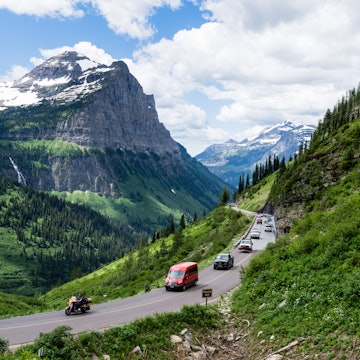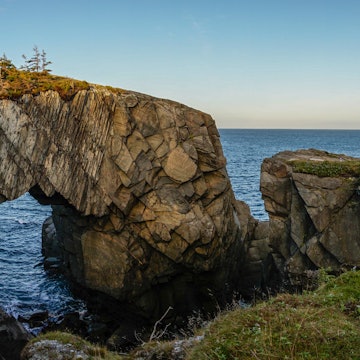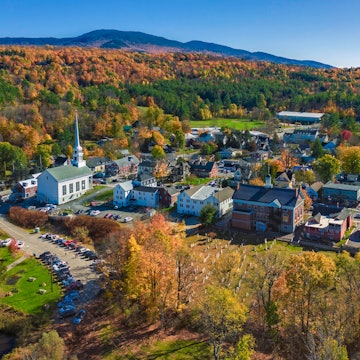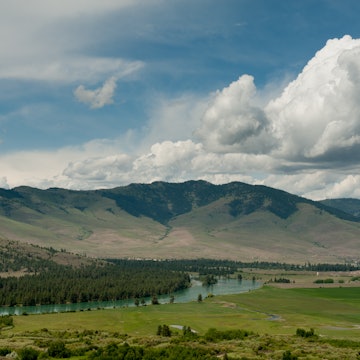
Ready for a challenge? Try these 10 epic long-distance hikes in the US

Mar 2, 2023 • 7 min read

The storied paths of the Appalachian Trail © Jonathan A. Mauer / Shutterstock
When adventurer Benton MacKaye conceived of the Appalachian Trail in 1921, he probably had no idea how thru-hiking, long-distance hiking and backpacking would one day take the outdoor industry by storm.
Today, thousands grab a backpack, stuff it with a stove, camping gear and food and take to the hills, canyons, valleys and plains for months at a time. Whether you’re seeking your first or tenth thru-hike, here are our picks for the best long hikes in the US for 2023.

1. Pacific Northwest Trail for a mountains-to-sea challenge
Trailheads: Glacier National Park, Montana and Cape Alava, Washington
Distance: 1200 miles
Duration: 60-75 days
This stunner has something few long-distance trails in the US have: a mountains-to-sea approach, encompassing the diversity of ocean and alpine terrain. Spanning 1200 miles through Montana, Idaho and Washington, crossing the Continental Divide and Cascade Range, there are curveballs galore on this rugged mountain-goat-infused trail.
Though it is shorter than a lot of the trails on this list, it’s no less demanding. With every mix of weather and climate along the way (not to mention grizzly bears) only avid and knowledgeable hikers should consider this hike.
2. Pacific Crest Trail for the most variable terrain on the planet
Trailheads: Campo, California and Manning Park, British Columbia
Distance: 2650 miles
Duration: About 5 months
This Hollywood-beautiful hiking trail also has a rough side. Spanning the three westernmost states in the lower 48, the 2650-mile Pacific Crest Trail covers the most variable terrain the planet has to offer – from the Mojave Desert in California, piggybacking on John Muir’s travels through the Sierras, then powering through the volcanos of Oregon and the Cascade Mountains of Washington.
As possibly the most popular long trail in the country, safety measures and information have become readily accessible and even the novice hiker can now attempt the PCT. Previous backpacking experience is always a good idea, though.

3. Continental Divide Trail for the volcanos, lakes and glaciers
Trailheads: The Continental Divide in Glacier National Park and The Pacific Ocean near Cape Alava, Washington
Distance: 3100 miles
Duration: 4 to 5 months
The Continental Divide is the literal spine of the country – marking the line where water will eventually run to either the Atlantic or Pacific Ocean. Running 3100 miles from Mexico to Canada through New Mexico, Colorado, Wyoming, Idaho and Montana, the Continental Divide offers volcano hopping, altitude sickness and heat exhaustion, coupled with grizzly bears and rattlesnakes. In short, it’s a great adventure.
Only experienced hikers should attempt the CDT. With many sections of off-trail navigating, elevations over 14,000 feet and variability in both terrain and weather, even the competent will have to stay on their toes.
4. Appalachian Trail for the most accessible thru-hiking trek
Trailheads: Springer Mountain, Georgia and Mount Katahdin, Maine
Distance: 2180 miles
Duration: 5 to 7 months
The ‘granddaddy’ of this list. Forming part of the ‘Triple Crown of Hiking’ alongside The Continental Divide Trail and the Pacific Crest Trail, the Appalachian Trail is also the most user-friendly. It's a great place to start your thru-hiking career as it’s so close to civilization for much of the route. Its long pedigree means there are pages and pages of history and literature for every step of the 2180-mile trek, which spans from the northern part of Georgia to the middle of Maine.
The perfect trail for long-distance hiking beginners. There are backcountry cabins and service roads where trail-weary walkers can make an easy escape. It's also close to many towns and airports for any emergencies.
In 2022, the new 343-mile Appalachian High Route, which connects Mount Mitchell with the Appalachian Trail, opened, so hikers can now access 50 of the 54 6000-foot summits in the Appalachians.

5. Florida Trail for the gators, mountain lions and bears
Trailheads: Big Cypress National Preserve and Fort Pickens at Gulf Islands National Seashore, Pensacola Beach
Distance: 1500 miles
Duration: 2 to 3 months
The Florida Trail never leaves the state but has no need to. Instead it spans 1500 miles across the peninsula and panhandle from Big Cypress National Preserve to deciduous forest. Along the way, hikers share the habitat with gators, mountain lions and black bears. It’s an exciting trail, if nothing else.
The Florida Trail is a great trail for all experience levels, as it is a relatively flat and low-elevation hike. But it is humid in Florida, so be prepared for bugs, sweat and some serious Vaseline use for rash on this pressure cooker of a hike.
6. Arizona Trail for the canyons, deserts and Grand Canyon
Trailheads: Coronado National Memorial and the Arizona–Utah border
Distance: 800 miles
Duration: 6 to 7 weeks
Think Arizona is nothing but heat and flat sand? Think again. This 800-mile trail explores deserts, mountains, canyons, and cultures from Mexico to Utah. Endlessly snaking from the state’s southern border to the northern border are grueling mountain switchbacks and the winding Grand Canyon National Park, one of the Holy Grails of hiking experiences.
A great trail for all experience levels. Be prepared to carry water for long, dry sections of trail. Do your homework on when to hike to avoid unnecessary struggles with everything from extreme heat to crowds in the Grand Canyon.
7. American Discovery Trail for the ultimate coast-to-coast adventure
Trailheads: Cape Henlopen, Delaware and Limantour Beach, California
Distance: 6800 miles
Duration: About a year and a half
The only trail in the US that goes coast-to-coast, this 6800-mile behemoth is for the most driven hikers. But for those motivated enough to walk it, this trail has it all: city, nature, mountains, deserts, oceans and plains. Crossing the Appalachian, Continental Divide and Pacific Crest Trails en route from Delaware to California, the wonders and discoveries are endless.
Only for the dedicated, the American Discovery Trail will take everything out of you, test every bone and muscle and try your patience to make you earn your coast-to-coast accomplishment.
8. North Country Trail for the grasslands and the great lakes
Trailheads: Lake Sakakawea State Park, North Dakota and Killington, Vermont
Distance: 4600 miles
Duration: 7 to 9 months
From the Grasslands to the lakes to the hills, the North Country Trail meanders from western North Dakota, 4600 miles to Vermont. Hikers traverse a tirelessly straight trail in the grasslands before transitioning to the winding shoreline of Lake Superior. Whether you’re looking to hike every cardinal direction, see four great lakes or eight states, this trail ticks all the items on the list for a classic American thru-hike.
Not for beginners, the length alone can break even the strongest of minds, including the most experienced. Though the terrain isn’t necessarily the most grueling (although sometimes challenging) the stamina needed makes this an advanced hiker’s trail.

9. Hayduke Trail for the most nimble rock scramblers
Trailheads: Arches National Park, Utah and the bottom of Zion Canyon in Zion National Park, Utah
Distance: 812 miles
Duration: 40 to 50 days
Named after a fictional character in The Monkey Wrench Gang, an infamous novel by Edward Abbey, the Hayduke Trail is a gem. No other trail both starts and finishes in a National Park. The 812-mile trail begins and ends in Utah, dipping into Arizona to join the Arizona Trail through Grand Canyon National Park. Choose this one for the solitude and serenity of the American Southwest.
With elevations from 1800 feet to well over 11,000, the Hayduke is not for the faint of heart or the novice hiker. Off-trail navigation, altitude, heat exhaustion and water rationing require patience and experience.
10. Ice Age Trail for a trip that traces millions of years of rock formations
Trailheads: Potawatomi State Park, Wisconsin and Interstate State Park near St. Croix Falls, Wisconsin
Distance: 1200 miles
Duration: 8 to 12 weeks
Don’t let the name scare you away. This 1200-mile historic trail in Wisconsin was carved by nature’s glacial forces. Every step takes you back millions of years, when ice up to two miles thick sculpted the landscape. From the shores of Lake Michigan to one of the tributaries of the mighty Mississippi River, the trail winds, turns and curves its way through forest, grasslands and rocky outcroppings.
This is a great trek for avid hikers, but not necessarily advanced ones. Geology buffs will especially appreciate a look at the formation of the land. Just pack plenty of water and all necessary creams and ointments. Bugs, chafing and rashes can ruin a hike.















